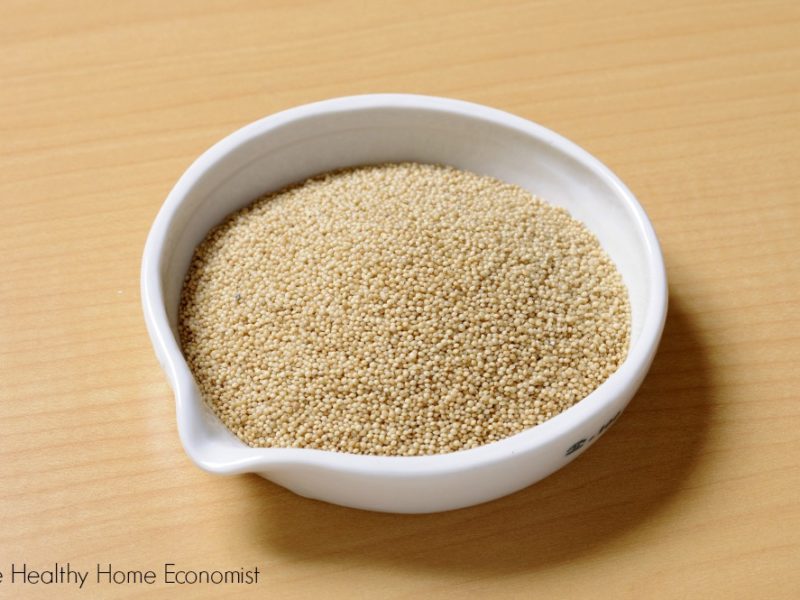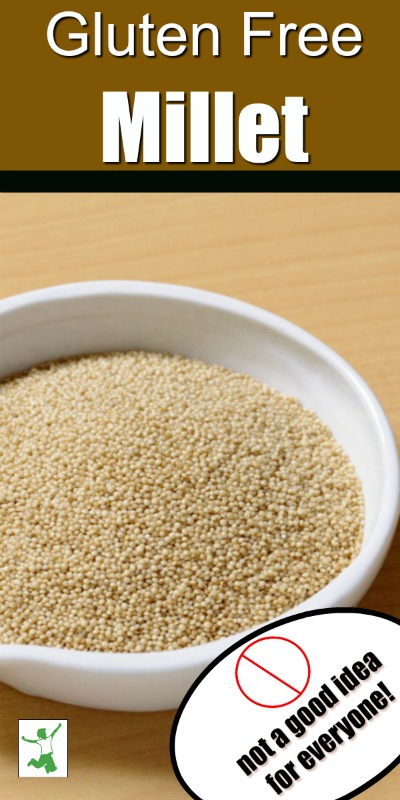Examination of why millet should optimally be eaten in moderation as a gluten-free whole grain in order to avoid disrupting hormone health.

Gluten allergies are clearly on the increase in our modern society. It seems like practically every other person I know these days has some sort of digestive issue that avoiding gluten would probably improve.
At the top of the list of gluten-containing foods is wheat. It is the indisputable, primary staple of the Western diet. Wheat is also the very foundation of the controversial USDA Food Pyramid.
Given how important bread and other wheat-based carbohydrates are to our society’s basic food requirements, it’s no wonder that folks seek a quick and easy substitute for wheat bread and wheat-based snacks when a gluten allergy or Celiac disease has been diagnosed.
Millet: Ancient Gluten-free Whole Grain
Enter millet. This ancient grain was cultivated in East Asia as far back as 10,000 years ago, according to archaeologists. Surprisingly, the cultivation of millet in prehistoric times was more prevalent than even rice, particularly in what is now China and the Korean peninsula.
Millet’s resistance to drought is perhaps the reason for its popularity in ancient times and its spread to Europe by 5000 B.C.
Despite the 5000 years cultivating this whole grain as a staple food, millet porridge is considered a traditional food in Russia as well as China. Use of millet is also widespread in Africa, like gluten-free teff, likely due to the drought-prone climate.
Millet Bread: Logical Substitute for Wheat
The protein structure of millet is quite similar to wheat. The one glaring exception is that millet is a gluten-free grain. Wheat contains copious amounts of this hard to digest plant protein.
When plain millet flour is used for baking bread (as opposed to homemade gluten-free flour or a healthy gluten-free flour mix from the store), the resulting loaf is light, white, and quite similar in texture to wheat bread. As a result, people who wish to avoid gluten tend to immediately gravitate to millet bread as the most logical and palatable substitute.
Millet bread is extremely popular in health food stores. Sami’s Bakery and Deland Bakery are two local bakeries that sell an absolute ton of millet bread to these stores around my local metro area.
I recently corresponded with a person up the East Coast of the USA who was consuming a lot of the millet/flax chips as an alternative to wheat-based snacks and had no idea of the potential health risks from consuming so much millet.
It was this discussion that led me to write this blog and warn folks about the dangers of consuming too much millet!
Potent Goitrogens
While millet does not contain gluten, it does contain goitrogens. These are substances that suppress thyroid activity and can lead to goiter. This condition involves enlargement of this very important gland which resides in the throat. Low iodine intake can also lead to goiter for those who rely on millet as a staple according to the Journal of Endocrinology and Metabolism.
Hypothyroidism is a serious and sometimes debilitating condition. It accompanies a weak or enlarged thyroid such as what occurs with goiter. Depression, difficulty losing weight, loss of hair, cold hands/feet, and fatigue are common hypothyroid symptoms. By some estimates, hypothyroidism is at epidemic proportions in Western society. (1)
Goitrogens in foods that contain them are usually reduced by cooking such as cruciferous vegetables like broccoli. However, cooking actually increases the goitrogenic effect of millet! Incidentally, the same effect occurs when fermenting soy.
Therefore, when folks begin eating large amounts of millet bread with a wholesale switch over from wheat, the thyroid suppressing effects of this simple dietary change can be profound. Injuring the thyroid can have a cascade effect on other glands as well. For example, those suffering from adrenal fatigue many times have thyroid issues as well.
Moderation is Critical
Protect your thyroid at all costs! It is a real challenge to unwind the effects of hypothyroidism once this vital gland is weakened or enlarged. Don’t take any chances with your thyroid health by consuming large amounts of millet bread or millet based snacks.
If gluten and/or wheat is a problem, then simply reduce bread consumption. Alternatively, use another grain that is both gluten-free and non-goitrogenic such as rice, oats or teff. Be sure to get quality, though, as rice is frequently high in arsenic.
Alternatively, try using grain-like gluten-free foods such as highly nutritious buckwheat, amaranth, or the starchy tuber cassava. They are excellent for baking too!
Millet bread consumption is fine in moderation if your thyroid is healthy – just don’t overdo it!
Given how difficult it is in modern society to maintain thyroid and overall glandular health, taking a chance by eating a lot of millet bread is a risky proposition indeed.
Traditional peoples did not have the constant stresses and strains on their glands like modern people do.
For example, they did not have to contend with pollution of their food, water, air and overall environment.
Therefore, we must be overprotective of our thyroid health. This includes avoiding regular consumption of foods that might impair it in any way.

Millet Alternatives That Preserve Thyroid Function
If you have thyroid issues and need alternatives to millet, here is a list of the healthiest options to consider.
- Einkorn Benefits (contains “good gluten“)
- Teff Benefits
- Yuca Root Benefits
- Arrowroot Benefits
- Wild Rice Benefits
- Farro (great if only modern wheat is the problem)








Mary, many thanks for that cassava/yuca & cooking goitrogenics information!
RE: Sarah’s reply to Winnie’s comments. I hope this helps.
onlinelibrary.wiley.com/doi/full/10.1111/1541-4337.12012#
Ate gluten free bread which had mullin in it at Disney after when leaving l had bad cramps and out it came with no notice all down my legs soak with poop in pants and shorts westerly can you help me understand l am celiac
I am a medical doctor in Uganda. I have lived and worked for many years in Eastern Uganda where millions of people eat cassava AND millet on a daily basis. If they avoided those foods they would starve to death because it is their staple diet. Moreover, the majority of the adults also consume millet beer regularly. However, goitres are NOT common and those that are identified are usually associated with low dietary intake of iodine.
I’m interested in learning what kind of millet and what kind of cassava cause thyroid issues.
Thanks.
Winnie.
Millet is a goitrogenic food. Eating goitrogenic foods cause goiter for those who are susceptible and/or do not have enough iodine in the diet. As a medical doctor, I am surprised you do not know this. If goiters are not common where you practice medicine and people consume millet regularly, this does not “prove” millet is non-goitrogenic. It simply proves that the people you are treating have a high amount of iodine in their diets. Westerners seem to be more prone to goiter especially now since the processed foods in the USA are LOADED with soy which is an even more powerful goitrogen than millet. Hope that helps!
Is there any problem if you eat it as swallow like 2 milk cup everyday like cooked and stair for some minutes thanks
I love to eat organic millet grain straight out of the packet but I have IBS and wonder if millet could adversely affect it?
Eating raw millet or any grain uncooked is very damaging to digestion! Yes, it could definitely adversely affect IBS.
We ate millet back home in Africa and no problems.
I’ve never understood why people recommend staying away from goitrogens. Goitrogens simply inhibit the uptake of iodine into the thyroid. The solution is simple; take more iodine. The FDA range for iodine is quite large: from 150mcg to 1,100mcg. Thus, just take 500-1,000mcg and you should be fine. 2mg (2,000mcg) and up acutely suppresses thyroid function, so best to keep bellow that unless you know what you’re doing. Also, ensure sufficient selenium intake when supplementing high doses of iodine.
Please define moderation. 2 slices a day, 2 a week? Thanks.
I would define moderation as a serving a few times a week on nonconsecutive days. In other words, a food that you don’t eat every day and when you do consume it, it is in small amounts.
Pearl milket is indigenous to AFRICA and some parts of india. Melanated people…particularly those with mostly african genetics have a very different biologically and genetically from those without. Even SUPERFOODS will not have the same effectiveness on those who lack that biology and can cause over-intoxication to those who try to ingest this in larger quantites over prolonged periods. For instance, researchers have found that african americans have the SAME digestive tract fluora that their indigenous ancestors have (regardless of being torn away and denied their ancestral diet for centuries now). Their biology is so becsuse of their genetic makeup. Eat according to your indigenous ancestral diet that feeds YOUR particular genetic makeup. Usurping and adopting a diet not designed for your particular needs may cause allergic reactions, intolerances, etc